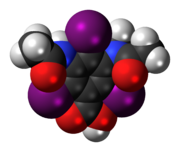Metrizoic acid
 | |
 | |
| Clinical data | |
|---|---|
| ATC code | |
| Identifiers | |
| |
JSmol) | |
| |
| |
Metrizoic acid is a
urinary tract), but it has been discontinued, at least in the US.[3]
It was used in form of its salts, metrizoates. Due to its high
osmolality, metrizoic acid had a risk of inducing allergic reactions higher than that of lower osmolar contrast media.[4]
Chemistry
The iodine content of metrizoate ranged from 370 mg/ml to 440 mg/ml, with osmolarity has high as 2100 mOsm/kg. The viscosity is 3.4 cP at 37 degree Celsius (human body temperature).[5]
Adverse effects
Side effects of metrizoate are: urticaria, headache, nausea, vomiting, dizziness, and hypotension. Other side effects include minor electrocardiographic changes such as tachycardia, bradycardia, and inversion of T waves.[6]
References
- S2CID 27742637.
- PMID 6147958.
- ^ "Metrizoic acid". DrugBank. Retrieved 3 March 2017.
- ^ "Metrizoic acid - C12H11I3N2O4". PubChem. U.S. National Library of Medicine. Retrieved 3 March 2017.
- ^ Patel R. "Applications in contrast imaging: contrast media basics - important considerations for the pharmacist" (PDF). Braco Diagnostics, Inc. Archived from the original (PDF) on 15 December 2022. Retrieved 15 December 2022.
- PMID 4166780.
